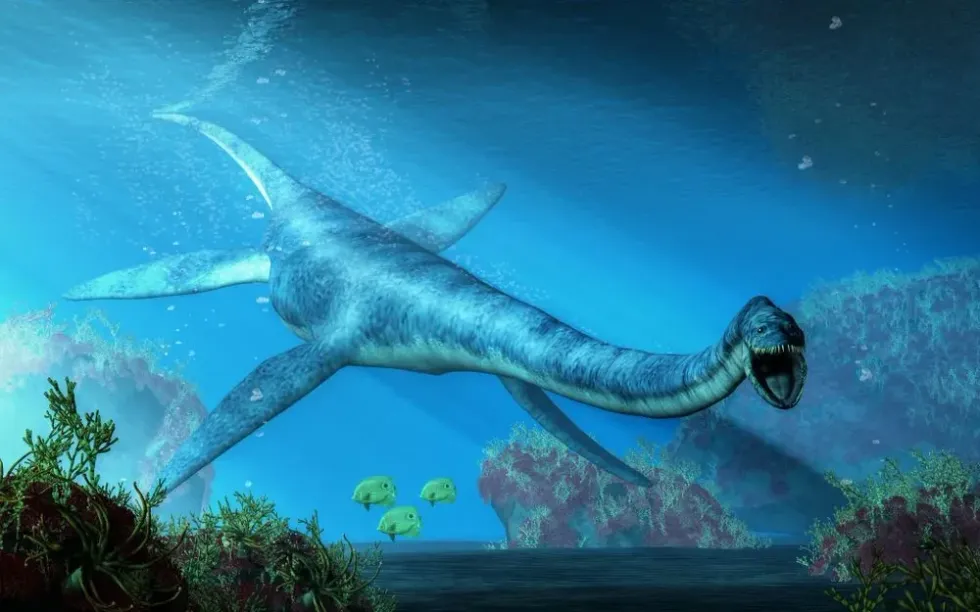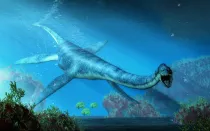Elasmosaurus represents a remarkable genus of marine reptiles that commandeered the primordial seas of Earth's past. A historical denizen of the vast prehistoric oceans, its existence has been illuminated by the discovery and study of fossils.
These remnants, entrenched in sediment and stone, are pivotal resources that bear testimony to the immense diversity that characterized aquatic life long ago.
Famed paleontologist Edward Drinker Cope, a seminal figure in the development of American paleontology, was instrumental in uncovering the identity of Elasmosaurus platyurus.
His detailed descriptions of this marine reptile unveiled an organism with a neck of extraordinary length, unprecedented in the annals of ancient and current marine fauna. Its neck was replete with an excess of vertebrae, a feature that distinguishes Elasmosaurus within the theater of natural history.
Often erroneously grouped with dinosaurs, Elasmosaurus flourished alongside them, sharing temporal space but differing in lineage.
As genuine marine reptiles, they captivated a realm separate from their terrestrial contemporaries, showcasing evolutionary trajectories uniquely adapted to an underwater way of life. This distinction is crucial, shaping human comprehension of the various life forms that once inhabited the Earth.
Elasmosaurus Interesting Facts

How do you pronounce 'Elasmosaurus'?
El-LAZ-mo-saw-rus' rolls off the tongue, evoking images of this ancient beast.
What type of dinosaur was it?
The Elasmosaurus is often mistaken for a dinosaur, but it was a marine reptile, closely related to other marine reptiles of the Mesozoic Era (252-66 million years ago).
In which geological period did this reptile roam the Earth?
Elasmosaurus thrived in the ocean waters during the Late Cretaceous Period around (80 million years ago).
When did the Elasmosaurus become extinct?
This marine reptile's tale came to an end around 66 million years ago, along with the extinction of the dinosaurs.
Where did this reptile live?
The Elasmosaurus species lived in the Western Kansas region, part of the vast Western Interior Seaway.
What was their habitat?

The aquatic life of Elasmosaurus was largely spent in marine environments where they could freely swim and breathe air from the water's surface.
Who did they live with?
It is presumed that Elasmosaurus shared its habitat with other marine reptiles, but their social structuring remains a topic of speculation among scientists.
How long did this reptile live?
Estimating the lifespan of a prehistoric creature is challenging, but marine reptiles were likely comparable to modern-day reptiles which can live several decades.
How did they reproduce?

Elasmosaurus, like many marine reptiles, is thought to have reproduced by giving live birth in the water, rather than laying eggs on land.
Elasmosaurus Fun Facts
What did they look like?
Elasmosaurus pictures typically depict this creature with a streamlined body, an extremely long neck filled with scores of neck vertebrae, a long tail, and paddle-like limbs perfect for life at sea.
How many bones did an Elasmosaurus have?
Elasmosaurus possessed an impressive array of bones, particularly within its extensive neck which hosted numerous vertebrae, a defining characteristic of its anatomy.
How did they communicate?
Scientists can only theorize how Elasmosaurus communicated, but it could have included tactile signals amplified through their long necks and possibly vocalizations echoing through marine corridors.
How big was the Elasmosaurus?
This extinct creature could grow to be about 34 ft (10.3 m) long, from the tips of its paddle-like flippers to the end of its whip-like tail.
How fast could this reptile move?
Given its streamlined body and flippers, the Elasmosaurus might have glided gracefully through the Cretaceous seas, but exact speeds are hard to determine without further evidence.
How much did an Elasmosaurus weigh?
Accurate adult size estimates for Elasmosaurus remain inconclusive, necessitating additional research for more definitive measurements.
What were the male and female names of the species?
There is no distinction in naming between male and female individuals within the genus Elasmosaurus.
What would you call a baby Elasmosaurus?
Babies were likely called baby Elasmosauruses; they were likely miniature versions of their parents with proportionally shorter necks and were probably independent from birth.
How aggressive were they?

With large, sharp teeth and an anatomy suited for predation, Elasmosaurus could have been quite aggressive when hunting, though this aggressiveness likely didn't carry over into unnecessary confrontations.
Did You Know…
The long-necked marine reptile fossils give rise to fascinating insights. For example, they had up to six teeth in their premaxilla.
Their genus name, Elasmosaurus, which means 'thin plate lizard', refers to a unique lateral longitudinal ridge found on their vertebrae. Some speculate that stories of the Loch Ness Monster may have been inspired by discoveries of the plesiosaur species, due to the visually striking similarities in their supposed forms.
The streamlined predator was distinctly adapted to thrive within the marine environment, utilizing its long neck and sharp teeth to navigate the ancient seas and capture prey. This adaptation to the marine environment distinguished it from terrestrial reptiles and underscored its role as an agile predator of the Mesozoic seas.
The thin plate lizard, a distinguished member of the plesiosaur order, is renowned for its unusually elongated neck compared to other genera within the same group, setting it apart as one of the most identifiable marine reptiles of its time.
The long-necked plesiosaur, with its elongated neck and paddle-like flippers, possessed one of the most streamlined bodies among the plesiosaurs, an adaptation that enabled this marine reptile to glide efficiently through the Cretaceous seas.
The prehistoric sea creature is well-known for an early paleontological mistake where the discoverer, Edward Drinker Cope, initially reconstructed the skeleton with the head at the wrong end of the animal, placing it on the tail instead of the long neck. This error was later corrected, further highlighting the creature's remarkable anatomy among its plesiosaur kin.
The marine reptile is often mistaken for similar animals within the plesiosaur order due to shared traits like flippers and a marine lifestyle; however, its prodigious neck length and specific skeletal features distinguish it from its contemporaries.
The aquatic predator, unlike many reptiles, is hypothesized to have given birth to live young rather than laying eggs, a trait that would have been advantageous in its marine environment where nesting on land was not a viable option.
The long-necked hunter, a formidable predator of its time, was equipped with fang-like teeth that were perfectly adapted for grasping its slippery prey in the depths of the marine environment where it hunted.
While some marine reptiles had shorter necks, the ancient sea creature stood out for its exceptionally long neck, which contained an astonishing number of vertebrae, unlike the shorter-necked varieties within the plesiosaur classification.
The Cretaceous marine reptile roamed the seas during the Late Cretaceous Period, a time when marine life was abundant and diverse, making this epoch a prominent chapter in the history of these impressive marine reptiles.
The holotype specimen ANSP 10081 of the ancient marine predator, housed at the Academy of Natural Sciences of Philadelphia, serves as the benchmark for identifying this species and provides researchers with invaluable information about its unique anatomical features.
The long-necked plesiosaur, like several other marine reptiles, is believed to have ingested stomach stones, known as gastroliths, which likely aided in digestion.
While Edward Drinker Cope was the first to describe Elasmosaurus platyurus, other scientists have since contributed to human understanding of this prehistoric sea creature, expanding on his initial findings with additional research and fossil discoveries.
The discovery of the long-necked marine reptile was made during the infamous 'Bone Wars', a period of intense and competitive fossil hunting and discovery in which remarkable and contentious paleontological finds, such as Elasmosaurus, were unearthed.
FAQs
Why is Elasmosaurus not a dinosaur?
The Elasmosaurus is classified as a marine reptile, not a dinosaur, due to fundamental differences in their anatomy, ecology, and evolutionary history.
Dinosaurs are a distinct group of terrestrial reptiles that have a unique pelvic structure, characterized by an upright stance where the legs extend directly beneath the body. This adaptation allowed dinosaurs to support their weight while moving on land.
Contrastingly, it was part of a group known as the plesiosaurs, which were specifically adapted to life in marine environments. Their limbs had evolved into flippers for swimming, and their bodies were more streamlined for aquatic efficiency.
Plesiosaurs, including Elasmosaurus, had neither the upright stance nor the pelvic configuration typical of dinosaurs. Furthermore, their overall morphology was sculpted by the demands of aquatic life, distinguishing them from the predominantly land-dwelling dinosaurs.
The term 'dinosaur' is used for a very specific subgroup of the clade Dinosauria, which does not include the aquatic plesiosaurs.
Therefore, although Elasmosaurus coexisted with dinosaurs during the Mesozoic Era (80.5 million years ago), it is not classified within the Dinosauria clade due to its distinctive marine adaptations and separate evolutionary lineage.
Does this reptile still exist?
It does not still exist; this genus of marine reptiles went extinct approximately 66 million years ago at the end of the Cretaceous Period during the Cretaceous-Paleogene (K-Pg) extinction event.
This event led to the mass extinction of many species, including all non-avian dinosaurs and large marine reptiles like the Elasmosaurus.
The evidence for their extinction comes from the fossil record, which shows a clear end to their existence around the same time as this massive extinction event.
No verifiable scientific evidence has been found to suggest that Elasmosaurus, or any other members of the plesiosaur family, survived beyond this period.
Despite occasional myths and legends about sightings of creatures resembling Elasmosaurus, such as the fabled Loch Ness Monster, there is no credible scientific data to support the ongoing existence of these prehistoric marine reptiles.
What's the difference between a plesiosaur and this reptile?
Elasmosaurus is a type of plesiosaur, which means that while all Elasmosauruses are plesiosaurs, not all plesiosaurs are Elasmosauruses.
The term 'plesiosaur' is used to describe an entire order of marine reptiles that lived during the Mesozoic Era (252-66 million years ago), characterized generally by small heads, long necks, broad bodies, and four flippers.
The key differences between Elasmosaurus and other plesiosaurs lie in the specifics of their physical characteristics. Elasmosaurus is known for its exceptionally long neck, which is made up of more vertebrae than most other plesiosaurs.
Furthermore, the skeletal structure, such as the shape of the shoulder and pelvic girdles, the flippers, and the length of the tail, can vary between different genera within the plesiosaur order. Elasmosaurus, with its distinctive features, represents one of the more specialized forms within this diverse group.
Was it a herbivore or a carnivore?
It was a carnivore. This classification is supported by its physical features and the fossil record. The structure of its jaws and teeth suggest it was well-adapted for catching and eating fish and other small marine animals. Its pointed teeth were ideal for seizing slippery prey in the water.
There is no evidence to suggest that it fed on plant material; rather, all known plesiosaurs, including Elasmosauruses, are believed to have been piscivorous or carnivorous by nature.
This creature stands as a towering figure in the pantheon of prehistoric marine creatures. With a legacy that includes curious longevity and a peculiar body structure, the species offers a glimpse into the incredible diversity that once flourished in our planet's oceans.
While its lineage ceased following the end of the Cretaceous, this dinosaur continues to influence human perception of the past, reminding you of the powerful, mysterious world of ancient marine reptiles.
Related Articles Around the Web













